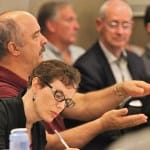City consultant says food and beverage tax could support $42.7M in bonds for convention center expansion, in the range of covering whole cost






At a meeting held Monday night at the Monroe Convention Center, elected officials from Bloomington and Monroe County governments got an analysis of revenue from the countywide food and beverage tax. It’s a one-percent levy that has been collected since February 2018.
Buzz Krohn, of O.W. Krohn and Associates, told the group that the city’s portion of the food and beverage tax would provide roughly $42.7 million of bonding capacity—on the “preferred” option for bonding.
That’s maybe $1.3 million shy of the $44 million needed for the current project to expand and renovate the convention center.
Another $15 million, for a 500–550 space parking garage, is reckoned by the city to be paid for out of tax increment finance (TIF) money, a different revenue stream from the food and beverage tax.
The amount of now estimated bonding capacity is more than the $30 million that’s been mentioned previously, a number that Bloomington’s mayor, John Hamilton, said on Monday had been pulled out of older pro formas.
One place the lower, $30-million figure might come from is an analysis done by Financial Solutions Group, Inc. for the Monroe County Council in December 2017. One scenario contemplated in that analysis is that revenues from the food and beverage tax will be $3 million a year.
That’s a smidgen less than the assumption for food and beverage tax revenues used in Krohn’s analysis presented on Monday. Krohn based the bond capacity estimates on a current rolling 12-month average of $3.034 million, which would stay flat over the course of a 20-year bond at 3.60 percent interest. The interest would require certain “credit enhancements”—pledges of additional revenue, like local income tax or TIF funds—in case the food and beverage tax did not cover the full amount of bond payments.
The preferred option is also the shortest bonding term contemplated in Krohn’s analysis. On one of the options—a 30-year term and an assumption of growth in food and beverage tax revenue—the bonding capacity climbs to as much as $58 million.
The current estimated bond capacity is based on the initial 18 months of revenue from the countywide food and beverage tax. “I’m encouraged by this,” Hamilton said, “it’s more than the $30 million, and it’s a good frame within which to move the project forward.”
The estimated bond capacity was portrayed as conservative at Monday’s meeting. County and city officials pushed back a bit on the idea that the estimate was conservative.
County councilor Marty Hawk said it would be better to take as a preferred option the one where coverage of the bond is 110 percent, not 100 percent.
City councilmember Steve Volan said that a spike in October 2018 revenues was likely not, as Krohn ventured, due to Indiana University homecoming activities. Instead, it was due to increased enforcement around that time, Volan believes. Volan serves on the Food & Beverage Tax Advisory Commission. Volan said it’d be important to wait and see what this year’s October numbers look like.

Council councilor Geoff Kim added that the figures from August this year are now available—Krohn’s numbers went only through July. And this year’s overall August figures are lower than in 2018—about $230,000 this year compared to $254,000 last year. McKim concluded that the rolling 12-month average as presented was at the “outer edge of plausibility for those numbers.”
The figure McKim gave at the meeting for August 2019 was around $204,000—because that would be the city of Bloomington’s roughly 89-percent share of the food and beverage tax revenue.
Surfacing several times throughout the meeting was idea that the convention center expansion is agreed to be funded exclusively by the city’s share of the food and beverage tax, and that the city has committed to spending all of its share on the expansion.
Also pushing back a bit on the idea that Krohn’s estimates were conservative was Bloomington city council president Dave Rollo, who wanted to know if a possible economic downturn had been factored into the estimates. Krohn’s response appeared to indicate that nothing like the 2008 recession had been incorporated into the analysis. The idea of an economic downturn 12 to 24 months from now was something Rollo also raised during this year’s 2020 budget hearings in August.
The idea that the bond capacity estimates were conservative got some support from a comment later in the meeting from Rob Hunden, with Hunden Partners. He said that once the convention center expansion was completed, given the nature of the convention business, it is reasonable to think that the food and beverage tax revenues will increase, and not just stay flat, as contemplated in the bond capacity analysis.
Hunden’s experience in the area of developing convention centers was tapped a few different times during the meeting, one of them in response to questions about parking. Volan, who chairs the city’s parking commission, focused on the convention center parking garage that’s to be constructed—in addition to the replacement garage on 4th Street the city is planning separately.
Volan wanted to know if the expectation would be that convention attendees will be allowed to park without paying, or if people who park there would pay for it. Hunden said typically convention center parking is not subsidized. From that Volan concluded that revenues from parking fees should be factored into the revenue available for building the convention center parking garage.
At the same time, Volan wondered if, for the same money as building a parking garage, shuttles could be run to get convention attendees from other parking areas to where they needed to go. The response Volan got to the ideas of shuttles was negative: Those convention centers requiring shuttles, instead of parking in the immediate vicinity, were less marketable to event planners.
Choices made based on the marketability of the convention center was a topic that came up more than once. David Greusel, with the project’s architect firm, Convergence Design, said that as an urban designer, he was not a fan of the “gerbil tubes”—elevated pedestrian walkways connecting buildings—that he’d drawn into one of the preliminary designs. But as a convention center designer, he recognized that such connections made the center more marketable.
A couple of times during Monday’s gathering, Mayor Hamilton let surface his view that he would have preferred that the steering committee that was in place would continue to work instead of convening such a large group, of potentially 20 elected officials. The meeting of Bloomington and Monroe County elected officials on Monday night achieved 75 percent attendance—15 of 20.
An alternative mentioned several times on Monday was the possibility of forming a capital improvements board. Thomas said that the county commissioners is planning to schedule a special session to get background information on formation of a CIB. County councilor Geoff McKim asked that the special session also include information on forming a building corporation. Thomas invited everyone to attend.
Hamilton said that a CIB was a good idea to pursue, but he thought in the meantime it would have been better to keep the steering committee—a nine-member group—working to move the project forward instead of a group of 20 elected officials.
At the conclusion of Monday’s meeting, the attendees agreed that the gathering would be organized by the city council and the county council. County commissioners and the mayor might or might not be invited to attend, Julie Thomas, president of the county’s board of commissioners said.
Table of Bond Capacity Options
| F&B Revenues (Bloomington Only) | Percent of current City F&B | Interest Rate (w/ credit enhancements) |
Comment | Term (Years) | Est. Bonding Capacity |
Coverage from City F&B | |
| $2,758,511 | 91% | 3.60% | More Conservative | 20 | $38,853,000 | 110% | |
| Baseline Scenario | $3,034,362 | 100% | 3.60% | Preferred Option | 20 | $42,738,000 | 100% |
| Assumes Add’l Growth | $3,337,798 | 110% | 3.60% | With 10% Growth | 20 | $47,012,000 | 1 for 1 |
| $2,758,511 | 91% | 3.75% | More Conservative | $44,255,000 | 91% | ||
| Baseline Scenario | $3,034,362 | 100% | 3.75% | 25 YR Baseline | 25 | $48,681,000 | 100% |
| Assumes Add’l Growth | $3,337,798 | 110% | 3.75% | With 10% Growth | 25 | $53,549,000 | 1 for 1 |
| $2,758,511 | 91% | 3.95% | More Conservative | 30 | $47,991,000 | 91% | |
| Baseline Scenario | $3,034,362 | 100% | 3.95% | 50 YR Baseline | 30 | $52,790,000 | 100% |
| Assumes Add’l Growth | $3,337,798 | 110% | 3.95% | With 10% Growth | 30 | $58,069,000 | 1 for 1 |




Comments ()